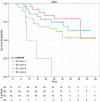Semiquantitative Computed Tomography Characteristics for Lung Adenocarcinoma and Their Association With Lung Cancer Survival
- PMID: 26077095
- PMCID: PMC4609593
- DOI: 10.1016/j.cllc.2015.05.007
Semiquantitative Computed Tomography Characteristics for Lung Adenocarcinoma and Their Association With Lung Cancer Survival
Abstract
In this study we developed 25 computed tomography descriptors among 117 patients with lung adenocarcinoma to semiquantitatively assess their association with overall survival. Pleural attachment was significantly associated with an increased risk of death and texture was most important for distinguishing histological subtypes. This approach has the potential to support automated analyses and develop decision-support clinical tools.
Background: Computed tomography (CT) characteristics derived from noninvasive images that represent the entire tumor might have diagnostic and prognostic value. The purpose of this study was to assess the association of a standardized set of semiquantitative CT characteristics of lung adenocarcinoma with overall survival.
Patients and methods: An initial set of CT descriptors was developed to semiquantitatively assess lung adenocarcinoma in patients (n = 117) who underwent resection. Survival analyses were used to determine the association between each characteristic and overall survival. Principle component analysis (PCA) was used to determine characteristics that might differentiate histological subtypes.
Results: Characteristics significantly associated with overall survival included pleural attachment (P < .001), air bronchogram (P = .03), and lymphadenopathy (P = .02). Multivariate analyses revealed pleural attachment was significantly associated with an increased risk of death overall (hazard ratio [HR], 3.21; 95% confidence interval [CI], 1.53-6.70) and among patients with lepidic predominant adenocarcinomas (HR, 5.85; 95% CI, 1.75-19.59), and lymphadenopathy was significantly associated with an increased risk of death among patients with adenocarcinomas without a predominant lepidic component (HR, 3.07; 95% CI, 1.09-8.70). A PCA model showed that texture (ground-glass opacity component) was most important for separating the 2 subtypes.
Conclusion: A subset of the semiquantitative characteristics described herein has prognostic importance and provides the ability to distinguish between different histological subtypes of lung adenocarcinoma.
Keywords: CT; Feature; Lepidic growth; Prognosis; Quantitative.
Copyright © 2015 The Authors. Published by Elsevier Inc. All rights reserved.
Figures










Comment in
-
CT Characteristics and Survival in Lung Adenocarcinoma.Clin Lung Cancer. 2016 Mar;17(2):e23. doi: 10.1016/j.cllc.2015.10.004. Epub 2015 Nov 10. Clin Lung Cancer. 2016. PMID: 26644177 No abstract available.
References
-
- Jemal A, Siegel R, Xu J, Ward E. Cancer statistics, 2010. CA: a cancer journal for clinicians. 2010;60:277–300. - PubMed
-
- Auerbach O, Garfinkel L. The changing pattern of lung carcinoma. Cancer. 1991;68:1973–1977. - PubMed
-
- Barsky SH, Cameron R, Osann KE, Tomita D, Holmes EC. Rising incidence of bronchioloalveolar lung carcinoma and its unique clinicopathologic features. Cancer. 1994;73:1163–1170. - PubMed
-
- Sica G, Yoshizawa A, Sima CS, et al. A grading system of lung adenocarcinomas based on histologic pattern is predictive of disease recurrence in stage I tumors. Am J Surg Pathol. 2010;34:1155–1162. - PubMed
Publication types
MeSH terms
Grants and funding
LinkOut - more resources
Full Text Sources
Other Literature Sources
Medical

